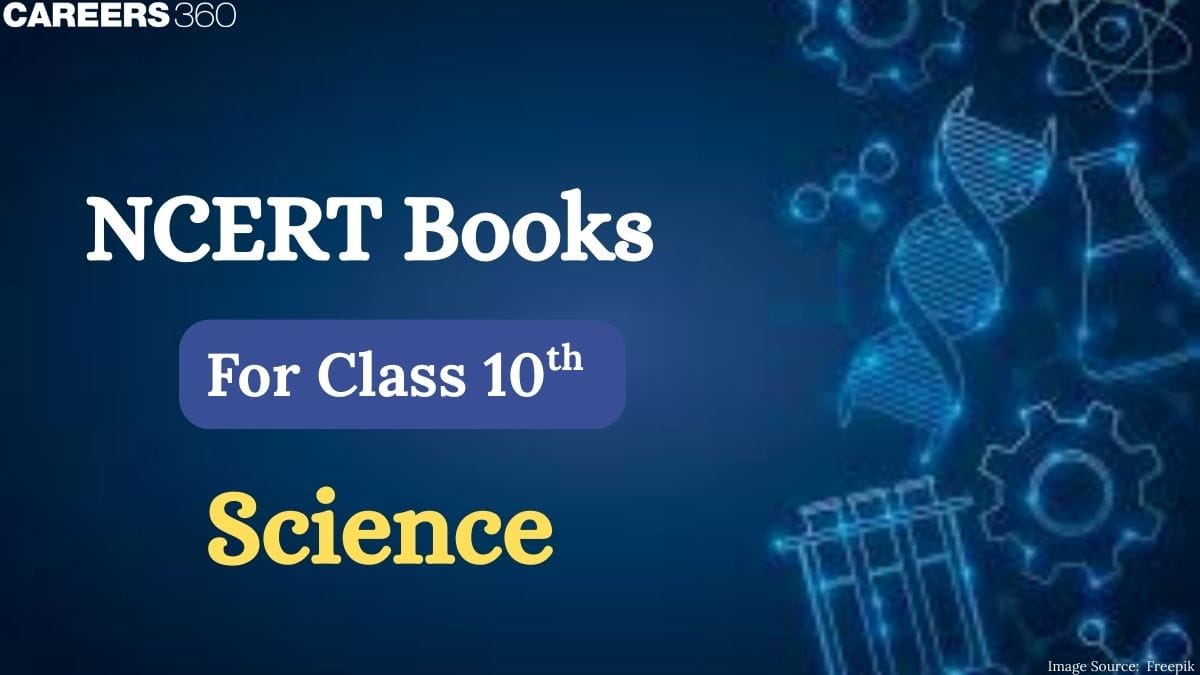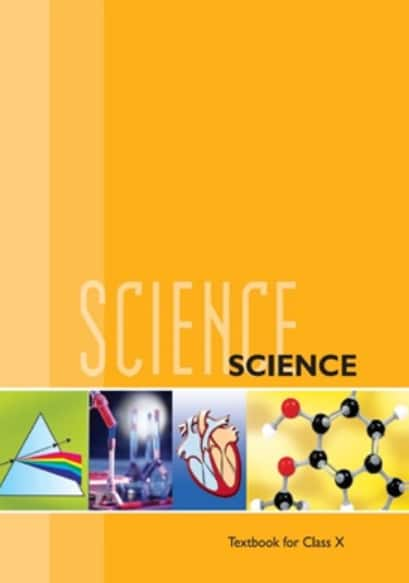NCERT Books for Class 10 Science – Download Free PDF (Latest Edition)
Science is one of the major subjects in a student's life, making them curious about everything from how eyes help us see to how to operate electric motors to power machines. The NCERT Book for Class 10 Science is one of the important sources for students studying for board exams. This book covers everything in a well-organised and simple way for the students to understand easily. In the NCERT Class 10 Science textbook, key chapters of Physics, Chemistry, and Biology are covered. It is available in Hindi, English, and Urdu and has chapters filled with clear explanations and helpful diagrams that will simplify complex concepts. Students can download the NCERT Class 10 Science book PDF from the official website of NCERT.
This Story also Contains
- Download NCERT Books for Class 10 Science PDF 2026
- NCERT Books for Class 10 Science 2026 Chapter-wise Links
- How to Download NCERT books for class 10 Science (2026) for Free?
- Best Reference Books for Class 10 Science
- How to prepare using the NCERT Book for Class 10 Science?
- Chapter-Wise Solutions of NCERT Class 10 Science
- NCERT Books for Class 10
- NCERT Syllabus for Class 10

These NCERT books are written in a very comprehensible and easy language and serve as an excellent resource for board exam preparation, as they will help you build a strong foundation of basic concepts. To perform well in exams, students should refer to NCERT solutions, as the solutions are designed by our subject experts in a very comprehensive and systematic way. The NCERT Book for Class 10 Science is a perfect blend of theory and practicals, which makes learning clear and enjoyable. NCERT Books for Class 10 help students to understand key concepts in detail. Instead of just memorising facts, students are now encouraged to observe, explore, and think scientifically about the world around them.
Download NCERT Books for Class 10 Science PDF 2026
Students preparing for board exams can download the Class 10 Science NCERT book PDF from here. This book covers all chapters with clear explanations, diagrams, and activities, making it the most reliable study material. With this PDF, students can study anytime, anywhere, without carrying heavy books.
| Book Title | Download link |
|---|---|
| NCERT Books for Class 10 Science 2026 PDF | Click here |
NCERT Books for Class 10 Science 2026 Chapter-wise Links
This textbook serves as the best study material for students to understand all topics easily. You can also get the Class 10 Science book PDF 2026.
| Chapters | English Medium | Hindi medium |
|---|---|---|
| Chapter 1 | रासायनिक अभिक्रियाएँ एवं समीकरण | |
| Chapter 2 | अम्ल, क्षारक एवं लवण | |
| Chapter 3 | धातु एवं अधातु | |
| Chapter 4 | कार्बन एवं उसके यौगिक | |
| Chapter 5 | Life Processes | जैव प्रक्रम |
| Chapter 6 | नियंत्रण एवं समन्वय | |
| Chapter 7 | जीव जनन कैसे करते हैं | |
| Chapter 8 | आनुवंशिकता | |
| Chapter 9 | प्रकाश - परावर्तन तथा अपवर्तन | |
| Chapter 10 | मानव नेत्र तथा रंग-बिरंगा संसार | |
| Chapter 11 | Electricity | विद्युत |
| Chapter 12 | विद्युत धारा के चुंबकीय प्रभाव | |
| Chapter 13 | हमारा पर्यावरण |
How to Download NCERT books for class 10 Science (2026) for Free?
Students can easily download the latest edition of the Class 10 Science book PDF 2026 from official sources. These textbooks are free to download and allows students to access the complete syllabus. Students can follow the steps given below for PDF Download.
- Go to the official website of NCERT, i.e, https://ncert.nic.in/
- Search "Textbook" in the search bar on the upper right-hand side of the site.
- "Textbooks PDF (I-XII)" will show up. Click on this.
- In the "Select class" dropdown, choose ' Class X' and in the "Select Subject" drop-down select "Science"
- Now, you are supposed to choose the name of the book.
- Click on the “Go” button.
- A list of chapters will appear, and you can download the individual chapters in PDF format.
- Click on the chapter-wise links and download the NCERT Books for Class 10 Science 2026 PDF for each chapter separately.
- Once downloaded, you can access the textbook offline anytime for easy reference and study.
NCERT Books for Class 10 Science: Cover Page

Best Reference Books for Class 10 Science
Along with the NCERT Books for Class 10 Science 2026, students can also use a few good reference books. These books, along with the Science textbook, can help improve performance in exams through clear explanations and extra practice.
| Subjects | Reference Books |
|---|---|
Physics | Physics by Lakhmir Singh and Manjit Kaur Principles of Physics S Chand books, – N.K. Chowdhry Fundamentals of Physics – Pradeep Publication |
Chemistry | Chemistry by Lakhmir Singh and Manjit Kaur |
Biology | Biology by Lakhmir Singh and Manjit Kaur |
How to prepare using the NCERT Book for Class 10 Science?
To prepare effectively with the Class 10 Science NCERT book, students must follow the tips given below:
- Read each chapter carefully and understand the concepts.
- Highlight important definitions, formulas, and diagrams.
- Solve the in-text and exercise questions at the end of each chapter.
- Revise regularly and practise sample papers along with NCERT questions.
Chapter-Wise Solutions of NCERT Class 10 Science
Get detailed and easy answers for each chapter of the Class 10 Science textbook to help you with better revision and exam preparation. These solutions are based on the Science textbook and follow the latest syllabus.
NCERT Books for Class 10
Students must download the books for the other key topics, whose links are given here, in addition to the Class 10 NCERT Science books.
NCERT books for Class 10 Maths
NCERT books for Class 10 English
NCERT books for Class 10 Social Science
NCERT Syllabus for Class 10
Click on the links below to download the NCERT Syllabus for Class 10 subject-wise.
Frequently Asked Questions (FAQs)
The NCERT Class 10 Science book covers a comprehensive curriculum designed by the National Council of Educational Research and Training (NCERT) for Class 10 students. It includes various topics from Physics, Chemistry, and Biology, aimed at giving students a solid understanding of fundamental scientific concepts and principles.
NCERT books are highly recommended for Class 10 Science as they provide a clear and concise explanation of concepts, which is crucial for understanding. They also include exercises, sample questions, and illustrations that help reinforce learning.
Yes, there are differences. The NCERT Science book is specifically designed to meet the curriculum requirements laid out by the CBSE, ensuring that it aligns well with exam patterns. Other reference books may contain additional problems, examples, or explanations, but they can sometimes deviate from the core syllabus.
The NCERT Class 10 Science book is widely available. You can find it in bookstores, educational supply stores, or directly from the NCERT website in PDF format, which can be downloaded for free.
Yes, the NCERT Class 10 Science book has been updated for the academic session 2025–26. Some chapters and topics have been revised or reduced as part of the syllabus rationalisation, so students should always refer to the latest PDF edition available on the official NCERT website.
To prepare for NCERT Class 10 Science, read each chapter carefully, make notes of key points and diagrams, and solve all exercise questions. Revise regularly and practise sample papers to strengthen understanding and improve exam readiness.
The NCERT Class 10 Science syllabus now has 13 chapters. These chapters cover Physics, Chemistry, and Biology concepts, and all are important for board exams and competitive exam preparation.
You can download the book from the official NCERT website or various educational platforms that offer free resources for students.
Yes, while NCERT books are primarily designed for board exams, they lay a strong conceptual foundation that can benefit students preparing for competitive exams like NEET and JEE.
Popular Questions
Courses After 12th
Applications for Admissions are open.
As per latest syllabus. Physics formulas, equations, & laws of class 11 & 12th chapters
JEE Main Important Chemistry formulas
Get nowAs per latest syllabus. Chemistry formulas, equations, & laws of class 11 & 12th chapters
JEE Main high scoring chapters and topics
Get nowAs per latest 2024 syllabus. Study 40% syllabus and score upto 100% marks in JEE
JEE Main Important Mathematics Formulas
Get nowAs per latest syllabus. Maths formulas, equations, & theorems of class 11 & 12th chapters
